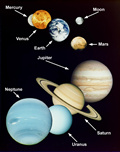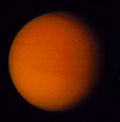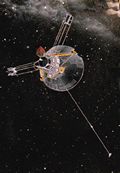 The place in space we call the Solar System consists of a not very
spectacular star in an average spiral galaxy we call the Milky Way Galaxy.
It has nine major planets, at least 60 planetary satellites or moons,
countless asteroids and comets and all space in between. Four of the planets,
Jupiter, Saturn, Neptune and Uranus have ring systems and seven have one
or more satellites, only Mercury and Venus do not possess a satellite.
Thousands of asteroids are in orbits between Mars and Jupiter, in a region
known as the asteroid belt, while most of the several billion comets travel
around the Sun in a spherical region approximately 50,000 times farther
out from the Sun than the orbit of the Earth.
The place in space we call the Solar System consists of a not very
spectacular star in an average spiral galaxy we call the Milky Way Galaxy.
It has nine major planets, at least 60 planetary satellites or moons,
countless asteroids and comets and all space in between. Four of the planets,
Jupiter, Saturn, Neptune and Uranus have ring systems and seven have one
or more satellites, only Mercury and Venus do not possess a satellite.
Thousands of asteroids are in orbits between Mars and Jupiter, in a region
known as the asteroid belt, while most of the several billion comets travel
around the Sun in a spherical region approximately 50,000 times farther
out from the Sun than the orbit of the Earth.
The Sun and its planets
Containing more than 99% of the mass of the Solar System, the Sun lies
at the centre of the Solar System; all the planets and asteroids move
around the Sun in elliptical orbits in the same direction as the Sun rotates,
counterclockwise.
The planets are divided into two distinct categories on the basis of their place in the Solar System. The inner terrestrial planets, Mercury, Venus, Earth, and Mars, are small high density planets with rocky composition. They lack ring systems, and have few or no satellites. Among the planets of the inner Solar System, only the Earth has a strong magnetic field.
In contrast, the outer Jovian planets, Jupiter, Saturn, Uranus, and
Neptune are large low density gaseous planets. The outer Jovian planets
are much more massive than the terrestrial planets and have immense atmospheres
composed mainly of hydrogen (H2) and helium (He). Each of the
outer planets, except for Pluto, has a magnetic field, a ring system,
and many satellites.
Pluto is a unique outer planet in that it is an icy, low-density body smaller than the Earth's Moon, resembling a giant comet nucleus or an icy satellite of one of the outer planets. Pluto has no rings and only a single satellite, Charon.
Satellites or moons

 Of the more than 60 satellites known, most orbit the Jovian planets.
They are extremely diverse in composition and represent a wide range of
environments. One of Jupiter's satellites, Io, is wracked by intense volcanism,
while Saturn's largest satellite, Titan, exhibits a primitive atmosphere
denser than that of the Earth. Neptune has a satellite, Triton, which
moves "backwards" in a retrograde orbit and features plumes of material
rising through its tenuous atmosphere from a surface that is very cold
at only 37 K or -236°C. Pictured are Io (top left) and Titan (right).
Of the more than 60 satellites known, most orbit the Jovian planets.
They are extremely diverse in composition and represent a wide range of
environments. One of Jupiter's satellites, Io, is wracked by intense volcanism,
while Saturn's largest satellite, Titan, exhibits a primitive atmosphere
denser than that of the Earth. Neptune has a satellite, Triton, which
moves "backwards" in a retrograde orbit and features plumes of material
rising through its tenuous atmosphere from a surface that is very cold
at only 37 K or -236°C. Pictured are Io (top left) and Titan (right).
Asteroids
The asteroids represent remnants of the planet-building process in the
inner Solar System. The asteroids found in the asteroid belt between Mars
and Jupiter are rocky bodies, ranging in size from the largest known,
Ceres, with a diameter of 930 kilometres to the microscopic dust.
Comets
Comets are very different from asteroids. They are made mainly of ices,
laced with dust and a rich variety of organic compounds. Typically, a
comet is an irregularly shaped object with a nucleus a few kilometres
across. The vast majority of comets spend most of their time at immense
distances from the Sun, way outside the orbit of Pluto, in fact up to
one-third of the way to the nearest star.
Not all comets exist in the dark reaches of outer space. Halley's Comet has a period of only 76 years, as opposed to the normal several million years. Halley's Comet is an example of a short-period comet that has been captured into a smaller orbit by a close encounter with Jupiter.
Interplanetary space and the solar
wind
 Space within the Solar System also contains protons, electrons, and
ions all streaming outward from the Sun in the form of the solar wind.
Giant flares or Sun spots on the Sun's surface expel matter, along with
light and other high-energy radiation into the near space of the Solar System.
Space within the Solar System also contains protons, electrons, and
ions all streaming outward from the Sun in the form of the solar wind.
Giant flares or Sun spots on the Sun's surface expel matter, along with
light and other high-energy radiation into the near space of the Solar System.
| Copyright owned by the State of Victoria (Department of Education and Early Childhood Development). Used with Permission. |